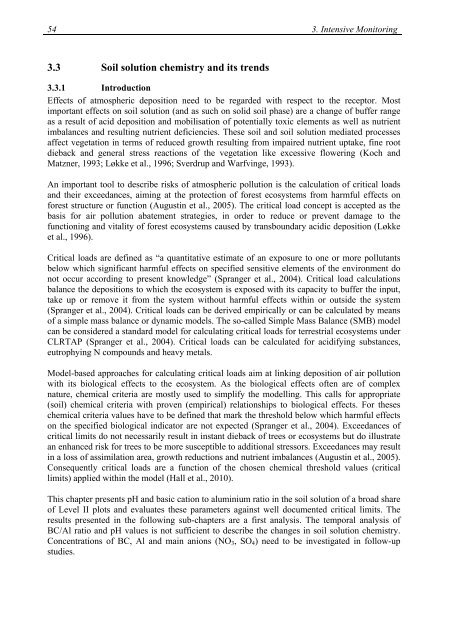Report - ICP Forests
Report - ICP Forests
Report - ICP Forests
Create successful ePaper yourself
Turn your PDF publications into a flip-book with our unique Google optimized e-Paper software.
54 3. Intensive Monitoring<br />
3.3 Soil solution chemistry and its trends<br />
3.3.1 Introduction<br />
Effects of atmospheric deposition need to be regarded with respect to the receptor. Most<br />
important effects on soil solution (and as such on solid soil phase) are a change of buffer range<br />
as a result of acid deposition and mobilisation of potentially toxic elements as well as nutrient<br />
imbalances and resulting nutrient deficiencies. These soil and soil solution mediated processes<br />
affect vegetation in terms of reduced growth resulting from impaired nutrient uptake, fine root<br />
dieback and general stress reactions of the vegetation like excessive flowering (Koch and<br />
Matzner, 1993; Løkke et al., 1996; Sverdrup and Warfvinge, 1993).<br />
An important tool to describe risks of atmospheric pollution is the calculation of critical loads<br />
and their exceedances, aiming at the protection of forest ecosystems from harmful effects on<br />
forest structure or function (Augustin et al., 2005). The critical load concept is accepted as the<br />
basis for air pollution abatement strategies, in order to reduce or prevent damage to the<br />
functioning and vitality of forest ecosystems caused by transboundary acidic deposition (Løkke<br />
et al., 1996).<br />
Critical loads are defined as “a quantitative estimate of an exposure to one or more pollutants<br />
below which significant harmful effects on specified sensitive elements of the environment do<br />
not occur according to present knowledge” (Spranger et al., 2004). Critical load calculations<br />
balance the depositions to which the ecosystem is exposed with its capacity to buffer the input,<br />
take up or remove it from the system without harmful effects within or outside the system<br />
(Spranger et al., 2004). Critical loads can be derived empirically or can be calculated by means<br />
of a simple mass balance or dynamic models. The so-called Simple Mass Balance (SMB) model<br />
can be considered a standard model for calculating critical loads for terrestrial ecosystems under<br />
CLRTAP (Spranger et al., 2004). Critical loads can be calculated for acidifying substances,<br />
eutrophying N compounds and heavy metals.<br />
Model-based approaches for calculating critical loads aim at linking deposition of air pollution<br />
with its biological effects to the ecosystem. As the biological effects often are of complex<br />
nature, chemical criteria are mostly used to simplify the modelling. This calls for appropriate<br />
(soil) chemical criteria with proven (empirical) relationships to biological effects. For theses<br />
chemical criteria values have to be defined that mark the threshold below which harmful effects<br />
on the specified biological indicator are not expected (Spranger et al., 2004). Exceedances of<br />
critical limits do not necessarily result in instant dieback of trees or ecosystems but do illustrate<br />
an enhanced risk for trees to be more susceptible to additional stressors. Exceedances may result<br />
in a loss of assimilation area, growth reductions and nutrient imbalances (Augustin et al., 2005).<br />
Consequently critical loads are a function of the chosen chemical threshold values (critical<br />
limits) applied within the model (Hall et al., 2010).<br />
This chapter presents pH and basic cation to aluminium ratio in the soil solution of a broad share<br />
of Level II plots and evaluates these parameters against well documented critical limits. The<br />
results presented in the following sub-chapters are a first analysis. The temporal analysis of<br />
BC/Al ratio and pH values is not sufficient to describe the changes in soil solution chemistry.<br />
Concentrations of BC, Al and main anions (NO 3 , SO 4 ) need to be investigated in follow-up<br />
studies.
















